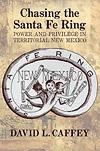
Chasing the Santa Fe Ring: Power and Privilege in Territorial New Mexico, by David L. Caffey, University of New Mexico Press, Albuquerque, 2014, $34.95
The Santa Fe Ring pops up in many stories (including two in this issue of Wild West) set in New Mexico Territory and rarely in a good light. It is often viewed as a shadowy organization consisting of powerful and corrupt mostly Republican government officials and those in allegiance to them. “Throughout the decade of the 1870s men commonly identified with the Santa Fe Ring seemingly had fingers in every pie,” writes Caffey. “Their economic interests included land, mining, ranching, railroad building, banking, wholesale and retail merchandising, and government contracts.” In the Colfax County War the Santa Fe Ring reportedly was behind the assassination of an outspoken reverend and tried to impose its will for political and economic gain. In the Lincoln County War the Santa Fe Ring backed the “House” (the L.G. Murphy/Jimmy Dolan faction) against the John Tunstall/Alexander McSween faction. The author does a great job of naming names—that is, naming the names of the men associated with the ring by other select sources. He also profiles alleged ring participants. This work is a must for anyone befuddled by vague references to the Santa Fe Ring or who wants to be enlightened about its rise and fall.
At the same time Caffey questions the organization’s very existence. “The Santa Fe Ring is essentially a construct articulated by adversaries to describe an observed pattern of relationships and activities; it is not a tangible entity.” In other words there is no paper trail. Near the end of the book, in his chapter “The Myth of the Ring,” Caffey says because there are no “artifacts confirming the existence of an organized conspiracy and identifying its participants,” then “it could be said with some justification that the Santa Fe Ring is mostly or entirely a myth.” He is not saying territorial administrators and leaders didn’t act in self-interest, abuse power and manipulate the law. Such things were happening nationwide during the Gilded Age. “Prevailing conditions,” he writes, “invited abuse in the form of official corruption and corporate exploitation of workers and consumers.” These same alleged Santa Fe Ring men, Caffey argues, were also the movers and the shakers who helped develop educational, cultural, civic and religious institutions and pushed for statehood. “For good or for ill,” he sums up, “these men applied their energy and Machiavellian cleverness to the pursuit of prosperity and influence.” No, these “Ringers” were not part of anything as corrupt and efficiently treacherous as the Democratic machine of Tammany Hall in New York City. But they were part of something bigger than themselves—an informal confederation of powerful, mostly (but not all) Euro-Americans who found reasons to work together even though they disdained the term Santa Fe Ring. A ring by any other name would still not smell sweet.
Editor




